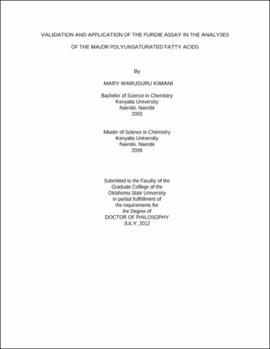| dc.contributor.advisor | Purdie, Neil | |
| dc.contributor.author | Kimani, Mary | |
| dc.date.accessioned | 2013-11-26T08:21:27Z | |
| dc.date.available | 2013-11-26T08:21:27Z | |
| dc.date.issued | 2012-07 | |
| dc.identifier.uri | https://hdl.handle.net/11244/6459 | |
| dc.description.abstract | Scope and Method of Study: | |
| dc.description.abstract | Cardiovascular diseases resulting from the accumulation of triglycerides in the heart blood vessels remain serious causes of human mortality around the world. This is in part due to lack of rapid and sensitive methods to quantify the different types of triglycerides associated with these diseases. To address this research gap, the objectives of this study were: | |
| dc.description.abstract | 1) To determine the sensitivity of a newly developed Purdie assay relative to GC-MS in the quantification of omega-3 and omega-6 polyunsaturated fatty acid (PUFAs) in human serum. | |
| dc.description.abstract | 2) To correlate the Purdie assay with the conventional methods. | |
| dc.description.abstract | 3) To quantify the levels of omega-3 and omega-6 PUFAs and their ratios in the Total Cholesterol (TC), High Density Lipoproteins Cholesterol (HDL-C) and Low Density Lipoprotein (LDL-C) fractions of human serum using the Purdie assay, | |
| dc.description.abstract | 4) To test and quantify the major PUFAs in different types of food. | |
| dc.description.abstract | This work contributed in part to quantifying 6 PUFAs and their ratios in human serum and foods. Blood serum specimens, obtained from Hillcrest Medical Center (HMC), were analyzed on the same day using GC-MS vs. the Purdie assay. Results obtained from the two methods were compared using SAS t-test and resulted in good agreement between the total omega-3 and total omega-6 PUFA levels and for the omega-6:omega-3 ratios. In an attempt to refine the Purdie assay, 24 human serum samples were analyzed for TC, HDL-C and LDL-C using Purdie assay. The results were correlated with the results obtained by HMC clinical staff at alpha = 0.05. Results showed no significant difference for TC and HDL-C data. | |
| dc.description.abstract | Findings and Conclusions: | |
| dc.description.abstract | Our findings suggest that Purdie assay is an accurate and sensitive assay that can be used to quantify PUFAs in human serum as well as in food products. These properties along with its relatively low cost makes it a useful assay in identification of the risks posed by different types of foods as well as early detection of triglyceride-related cardiovascular diseases. | |
| dc.format | application/pdf | |
| dc.language | en_US | |
| dc.rights | Copyright is held by the author who has granted the Oklahoma State University Library the non-exclusive right to share this material in its institutional repository. Contact Digital Library Services at lib-dls@okstate.edu or 405-744-9161 for the permission policy on the use, reproduction or distribution of this material. | |
| dc.title | Validation and application of the Purdie assay in the analyses of the major polyunsaturated fatty acids | |
| dc.contributor.committeeMember | Blum, Frank D. | |
| dc.contributor.committeeMember | Ausman, Kevin Douglas | |
| dc.contributor.committeeMember | Berlin, Kenneth Darrell | |
| dc.contributor.committeeMember | Lucas, Edralin A. | |
| osu.filename | Kimani_okstate_0664D_12200 | |
| osu.accesstype | Open Access | |
| dc.type.genre | Dissertation | |
| dc.type.material | Text | |
| dc.subject.keywords | a new novel method for the analyses of fatty acids in biological samples and foods | |
| thesis.degree.discipline | Chemistry | |
| thesis.degree.grantor | Oklahoma State University | |
